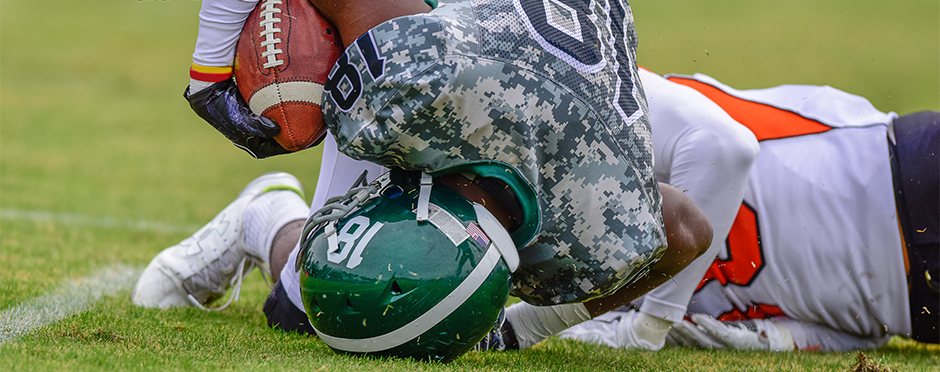
Common Football Injuries
Leave a CommentHead, shoulders, knees, and toes – football is a rigorous sport and can be the source of various injuries. Some injuries are more common, and some are less common. Some injuries heal quickly with rehabilitation, whereas others heal slowly and may require surgery. Let’s look at some of the more common injuries in football.
Head
- Concussions are a form of mild traumatic brain injuries that occur due to the brain moving within the skull. Concussions typically happen because of a blow to the head or neck area.
Shoulder
- Acromioclavicular (AC) joint sprains typically occur with direct blows to or direct falls onto the shoulder. They are also known as shoulder separations or AC joint separations. These injuries are graded one through six based on severity.
- Labrum tears occur because of trauma to the shoulder. The labrum is a ring of cartilage in the shoulder, and a tear can cause decreased stability of the shoulder joint, pain, and reduced function.
- Shoulder dislocations occur with trauma to the shoulder and can cause structural damage to muscles, ligaments, and tendons around the shoulder. These injuries are classified as full dislocations and partial dislocations (subluxations).
Elbow
- Elbow dislocations occur due to trauma to the elbow. Dislocation refers to a joint that is no longer in its usual position following a shift of bones that make up that joint. Elbow dislocations cause pain, reduced range of motion, reduced strength, and reduced function.
Hand
- Metacarpal fractures involve injury to one or more of the long bones in the hand that line up with the fingers. Fractures are classified based on bone position following the break and whether the fracture breaks through the skin.
Hip
- Hip dislocations are rare and require a significant amount of trauma to the hip joint to occur. The hip is a naturally stable joint, so dislocations create an increased degree of instability. These injuries can cause injury to the surrounding bone, cartilage, and blood vessels.
- Labrum tears can occur over time or with trauma. Tears to the labrum can be a source of groin pain, reduced range of motion, and reduced overall function of the hip. Management of hip labrum tears can occur with rehabilitation or surgery, depending on patient presentation.
Knee
- Ligament tears can occur in the presence and absence of trauma to the knee. Medial collateral ligament (MCL) and anterior cruciate ligament (ACL) tears are common football knee injuries. Injuries to the lateral collateral ligament (LCL) and posterior cruciate ligament (PCL) are less common.
- Meniscus tears can occur with wear and tear over time or in the presence of trauma. The meniscus is shock-absorbing cartilage in the knee joint that can be a source of pain and instability when injured.
Ankle
- Low ankle sprains are the traditional “roll of the ankle,” which cause an overstretching of the ligaments on the lateral (outside) of the ankle. Severity ranges from low to high and is graded on a scale from one to three.
- High ankle sprains involve injury to the syndesmosis joint just above the ankle. The syndesmosis is a naturally stable joint that encounters reduced stability when injured. Rehabilitation is typically longer for high ankle sprains than low ankle sprains.
- Ankle fractures involve trauma to the ankle. Just like fractures of the hand, ankle fractures are classified based on fracture location and bone position following the break. The course of treatment is determined following a thorough examination.
Foot
- Lisfranc injuries are injuries to the midfoot and include fracture, dislocation, and sprains. These can occur independently of each other or in unison. Severity dictates management using conservative care techniques like physical therapy versus surgical intervention.
- Jones fractures are fractures that occur to the fifth metatarsal in the foot. The fifth metatarsal is the long bone in the foot in line with the pinky toe. Surgery is often the course of action to repair these fractures.
- Turf toe entails over-extension of the big toe, which overstretches the ligaments that support the toe. This causes pain and difficulty pushing off while running, jumping, and cutting.
Physical Therapy for Football Injuries
Have you been injured while playing football or know someone who has? Our clinicians treat football players of all ages and levels whether they have an injury as listed above or are looking for tips to optimize their game. Get started today by scheduling a Free Assessment at an Athletico near you today. Free Assessments are available in-clinic and virtually through our Telehealth platform.
The Athletico blog is an educational resource written by Athletico employees. Athletico bloggers are licensed professionals who abide by the code of ethics outlined by their respective professional associations. The content published in blog posts represents the opinion of the individual author based on their expertise and experience. The content provided in this blog is for informational purposes only, does not constitute medical advice and should not be relied on for making personal health decisions.
